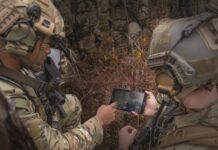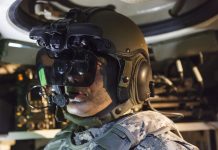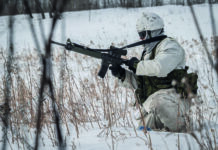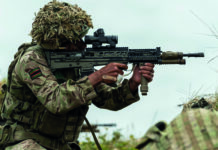Vehicle commanders and crews face an increasing number of threats from all directions on the modern battlefield. Optimising a vehicle’s tactical situational awareness capabilities is one way of optimising the crew’s chance of survival.
Armoured vehicle sensor capabilities continue to evolve to provide increased situational awareness (SA) for vehicle commanders. Whether electro-optical, acoustic or otherwise, such SA sensors and local SA systems (LSAS) are improving the abilities of onboard crew to make informed, tactical battlefield decisions as they face modern, asymmetric threats, often in intense, high-anxiety urban scenarios. Having eyes — and ears — in the back of your head, as well as on top of it, will be crucial if armoured vehicles and crew are to survive on tomorrow’s battlefield. But lots of sensors means lots of real-time data, so armoured vehicle-mounted sensors must not only be able to gather tactical SA information, but onboard systems must also be able to process and use that information in the blink of an eye so the crew can respond appropriately.
Not only will optimal SA aboard each vehicle in, say, a mechanised battalion, enable future armoured vehicle operations to be better informed to handle the tactical situation, but it will also help the whole battalion and wider battlegroup to achieve and maintain strategic advantage on the battlefield. This article outlines what SA is and takes a look at some latest SA developments and systems from a handful of leading manufacturers.
Understanding SA
SA can be explained as the perception, understanding and anticipation of all the various factors within an operational environment required for operatives/vehicle crew to act effectively within that particular environment. It is an absolute prerequisite in order for a commander or operative to execute timely and accurate decision-making in a fast and highly stressful scenario, such as that of an Infantry Fighting Vehicle (IFV) operating and disembarking its occupants into an active operational situation. With the introduction of ever more sophisticated electronic sensor and optronic technologies onto the battlefield, this is expected to improve vehicular – and dismounted –SA by providing the right information, at the right time and in the right format for all concerned to make the best possible decisions, not only for a mission to succeed, but also for a vehicle and its crew, (together with other friendlies in the tactical locale), to survive.
Throwing a whole load of information and visual data from a myriad of sensors at any soldier, whether commander or otherwise, about local threats, terrain, uncertainties and more, must not overwhelm, confuse or create sensory overload in the minds of recipients. It must help them perceive immediate threats, make accurate time and space appreciations of a developing tactical situation, and comprehend how a particular action by them will turn out: If I do this, so what? If I do that, so what? Effectively, the system must conduct a digital combat appreciation that can be easily understood, it must be able to prioritise and highlight the more critical aspects and threats in the immediate tactical environment.
The sophistication of the SA sensors and core processing elements coming out of industry is, thankfully, taking all these issues into account. So, let us now take a look at just a few of those systems.
Companies and Solutions
Enabling commanders at the tactical edge of operations to receive optimum levels of SA needed to do their job is the Move Out/Jump Off (MOJO) terminal from Viasat’s Government Systems division. It is a reduced-form-factor terminal that allows it to be integrated onboard a variety of platforms, including ground vehicles and small maritime vessels. The terminal – based on Viasat’s KOR-24A Small Tactical Terminal (STT) – can be operated on-the-move to ensure Line-of-Sight (LoS) and Beyond-LoS communication over air, land and maritime environments and is a gateway that gives a 360 degree view of the battlespace by blending air and ground situation pictures, and provides at least three-channel, simultaneous access to disparate and incompatible communications networks, including Link 16, TADIL-J, VHF/UHF (SINCGARS, SRW, ANW2C, SATCOM, IW and DAMA) and another embedded radio such as EPLRS/SADL networking. MOJO also features an integrated computer capable of hosting and controlling gateway applications, which allow soldiers to select their own mission-specific applications and external displays that best suit their information and SA needs. It is designed to provide access to a Common Operating Picture (COP) across disparate networks and in remote and austere locations, so that such things as targeting cycles can be shortened and any collateral damage can be reduced during fire missions, by providing a much greater SA picture to the commander.
Importantly, Viasat’s MOJO also enhances interoperability between US and coalition partners, providing access to the COP through Link 16 or SADL-enabled platforms, among others. The system can be set up by a single end user within about 15 minutes with little or no training, making it a rapidly deployable communications solution capable of being operated anywhere in the world for large-scale combat operations. MOJO is expected to be networked to Viasat’s planned XVI Link 16 Low Earth Orbit satellite to extend its ability to communicate with BLoS assets in the immediate battlespace.
360 Views
Some five years ago, BAE Systems drew on advanced fighter jet technology to come up with its BattleView 360 SA system, which effectively allows armoured vehicle crews to ‘see through’ their vehicles, in real time, providing commanders with, as the name implies, a complete 360-degree view of the battlespace surrounding the vehicle.
The system seamlessly integrates with multiple existing vehicle types (such as CV90s, BRADLEY IFVs as well as UAVs) and their onboard electronics and communications systems. It has, at its core, a digital mapping system that collates, displays, and tracks the positions of all surrounding features of interest in either two- or three-dimensional modes, allowing vehicle commanders to make rapid and informed decisions and communicate plans and instructions to their crew, as well as other friendly vehicles. Displayed imagery can, for example, enable a commander to distinguish between friend or foe in order to either engage the enemy, or for friendly forces to find a safe route out of enemy sight and range.
According to the company, the head-worn part of the system including the helmet-mounted monocle, synchronises with vehicle cameras to provide its ‘see-through’ capability in both visible and infrared modes. And once disembarked from their mother vehicle, dismounts can also relay further SA information back to the vehicle for processing and, if necessary, wider dissemination to friendly forces. BattleView 360 has a head-down, touch-screen display that allows commanders to assess incoming information, including from the displays of other crew members, such as a gunner, or driver, thereby optimising his own decision-making capabilities. Key features displayed and enabled by BattleView 360 include: blue force positions, route planning, UAV route planning, route progress monitoring, dead-ground display, red-ground display – namely, ground that can be seen by hostile forces – and areas of uncertainty.
Another 360-degree view of the battlefield is provided by the see-through-armour system – SETAS – from Hensoldt, which uses an array of high-resolution cameras, including 12-megapixel CMOS day cameras and uncooled thermal imagers, in ruggedised, integrated modules that can be situated around the hull of a wide variety of latest tracked and wheeled armoured vehicles types, as well as legacy platforms, to give commanders and crew an all-round view of their external environment, in real time, 24 hours a day, while remaining closed down. Hensoldt’s sensors offer a range a capabilities to protect and improve survivability, with sensor data fusion, artificial intelligence, augmented reality and other technologies playing a role in their function. But it is SETAS that specifically represents the company’s latest and most advanced SA sensor system. Its CMOS camera, for example, enables it to recognise the human form, such as a sniper, out to 300m, providing crew sufficient time for appropriate decision-making actions. The system has a powerful Central Image Processing Unit (CIPU) that can handle huge amounts of imagery data generated by the sensors, running complex algorithms so camera feeds from each SETAS module can be ‘stitched’ together to give a seamless, 360-degree view of what’s going on outside the vehicle. The CIPU features up to eight outputs, allowing eight crew members to view the low-latency, video feed via a human-machine interface (HMI). Crews can use standard display screens as well as helmet-mounted displays that give instant orientation, as SETAS has an open HMI architecture. The system also allows each user to have graphical overlays that assist further with SA and decision making. For instance, a crew member could choose to have vehicle information overlaid on his SETAS view, giving them up-to-date information on how the vehicle is performing using the NATO Generic Vehicle Architecture (NGVA) to receive vehicle data, or a soldier could have military symbols from the battlefield management system (BMS) overlaid on their view, giving them indications of enemy and friendly forces before they dismount.
A number of new software-enabled features for SETAS are currently in development, including a picture-in-picture mode and digital image enhancement, the latter includes digital image stabilisation enhancement to allow crew members or remote users to focus on specific objects while the vehicle is moving. By using machine-learning algorithms, SETAS can identify targets, thereby reducing crew workload. In the future, the company intends to network SETAS with other vehicle sensors, including Hensoldt’s Multifunctional Self-Protection System (MUSS) and shot detection systems, both of which alert the crew to potential missile and ballistic threats. In so doing, SETAS will evolve from a standalone SA solution to become a powerful sensor-management system, incorporating advanced AI algorithms and connecting a host of sensors to provide optimum SA and survival capabilities for vehicle commanders and crew.
With an increasing number of 360-degree solutions now available, it’s worth mentioning OCTOPUS 360 from Israel’s Computech International (CTI). This is an SA system designed for combat teams in closed-down vehicles in hostile environments that provides a 360-degree, in-motion, visual solution to armoured vehicle crews; it processes data from hull-mounted cameras and advanced sensors to display a ‘stitched-together’, 360-degree, tactical view of the local environment around the vehicle. The system supports multiple monitors to create a full-view, real-world picture, and has Picture-in-Picture capabilities, which display data in real-time, telemetry streams and markers, and it also offers real-time recording and off-line playback for debriefing and simulation. Virtual Reality and Augmented Reality glasses can be connected to improve user experience, and multiple display modes are available to support users with different operational requirements. OCTOPUS 360 provides real-time object detection and marking with dynamic tracking, compression and image transmission which enable remote monitoring. The system can be installed on any platform, from light to heavy vehicles, working in-sync with the vehicle’s existing electronic systems to provide combat squads with a complete, real-time SA picture.
A Citadel Footnote
While not every vehicular SA system can be mentioned in such a brief article, the local SA pedigree of Copenhagen Sensor Technology, CST, deserves a mention. Yet, it, too, has an array of solutions that are too many to be covered here. Suffice to highlight CST’s CITADEL LSAS, which is a complete vehicle system consisting of both SA cameras and driver-vision-enhancement cameras. Citadel itself has several versions, including Citadel Panorama, Compact/Thermal, Connex, Dual and Quattuor, to name just some. CST says that Citadel, in its various formats, is suited to vehicle mid-life upgrades and retrofit programmes, due to its analogue core, enabling it to be integrated into existing analogue vehicle architecture. Citadel provides day and night vision using a combination of visual and thermal night vision devices and has been field proven on a variety of tracked and wheeled armoured vehicles.












